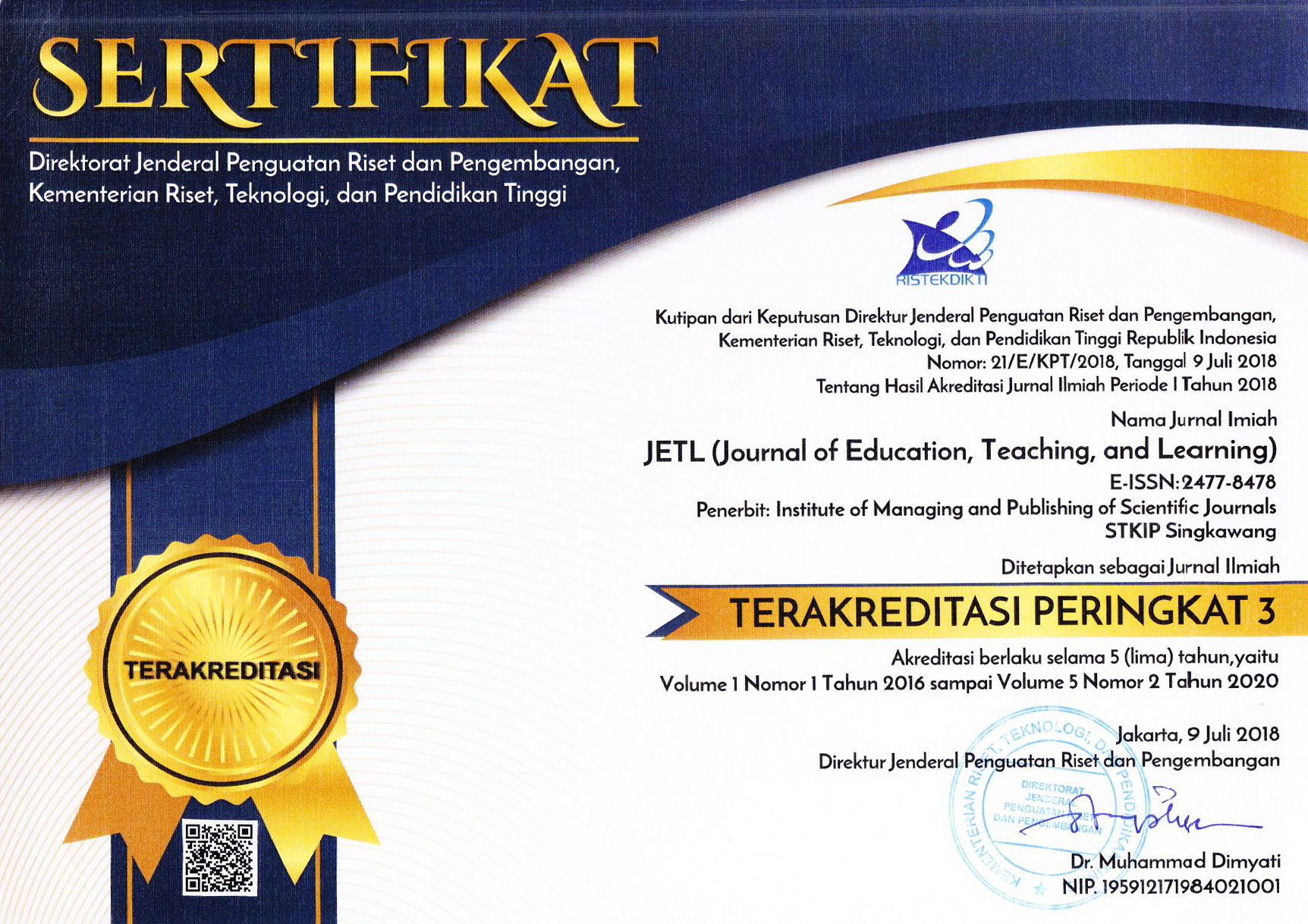Learning Model Development of Memorizing The Qur'an Through Integration of Internal and External Representation
Abstract
Keywords
Full Text:
PDFReferences
Ahmad, K. (2014). Implementation Of Othman Method On Memorization The Quran: A Study In Sulaymaniyyah Institute, Malaysia. Katalog BPS, XXXIII(2), 81–87. https://doi.org/10.1007/s13398-014-0173-7.2
Al-Mosallam, E. A. (2015). Towards Improving Quran Memorization Using Mind Maps. Proceedings - 2013 Taibah University International Conference on Advances in Information Technology for the Holy Quran and Its Sciences, NOORIC 2013, 128–132. https://doi.org/10.1109/NOORIC.2013.36
Al Hafiz, M. M., Yusof, M. F., Ghazali, M. A., & Md. Sawari, S. S. (2016). Descriptive Qualitative Teaching Method of Memorization in The Institution of Tahfiz Al-Quran Wal Qiraat Pulai Condong and the Students’ Level of Academic Excellence. Mediterranean Journal of Social Sciences, 7(1), 79–85. https://doi.org/10.5901/mjss.2016.v7n1s1p79
AlZoubi, A. A. Y. (2013). Use of Information Technology in the Teaching of Quran Recitation (Qira’at) - Electronic Miqrah as a Model. 2013 Taibah University International Conference on Advances in Information Technology for the Holy Quran and Its Sciences, 593–621. https://doi.org/10.1109/NOORIC.2013.99
Ariffin, S., Abdullah, M., Suliaman, I., Ahmad, K., Deraman, F., Shah, F. A., Zulkifli, Y., Yusoff, M., Munirah, M., Razzak, A., Murshidi, M., Noor, M., Meftah, J. T., Kasar, A. K., Amir, S., Roslan, M., & Nor, M. (2013). Effective Techniques of Memorizing the Quran: A Study at Madrasah tahfiz Al-quran, Terengganu, Malaysia. Middle-East Journal of Scientific Research, 13(1), 45–48. https://doi.org/10.5829/idosi.mejsr.2013.13.1.1762
Boneva, D., & Mihova, E. (2014). Learning Styles and Learning Preferences. Dyslang: Dyslexia and Additional Academic Language Learning, 8.
Dick, W., Carey, L., & Carey, J. O. (2009). The Systematic Design of Instruction. Longman.
Franklin, A., & Zhang, J. (2014). Cognitive Considerations for Health Information Technology. In Clinical Decision Support: The Road to Broad Adoption: Second Edition (Second Edi). Elsevier Inc. https://doi.org/10.1016/B978-0-12-398476-0.00022-1
Gall, M. D., Gall, J. P., & Borg, W. R. (2003). Educational Research An Introduction (A. E. Burvikovs (ed.); 7th ed.). Pearson Education, Inc.
Gates, P. (2017). The Importance of Diagrams, Graphics and Other Visual Representations in STEM Teaching. In STEM Education in the Junior Secondary: The State of Play (STEM Educa, pp. 1–294). Springer Nature Singapore. https://doi.org/10.1007/978-981-10-5448-8
Honey, C. J., Newman, E. L., & Schapiro, A. C. (2017). Switching between internal and external modes : A multiscale learning principle. Network Neuroscience, 1(4), 339–356. https://doi.org/10.1162/netn_a_00024
Johnson-laird, P. N. (2010). Mental Models and Human Reasoning. Psichological and Cognitive Science. https://doi.org/https://doi.org/10.1073/pnas.1012933107
Kizilirmak, J. M., Glim, S., Darna, M., & Khader, P. H. (2021). Selective attention to stimulus representations in perception and memory: commonalities and differences. Psychological Research. https://doi.org/10.1007/s00426-020-01469-z
Kuorikoski, J., & Ylikoski, P. (2015). External representations and scientific understanding. Synthese, 192(12), 3817–3837. https://doi.org/10.1007/s11229-014-0591-2
McLane, S., Turley, J. P., Esquivel, A., Engebretson, J., Smith, K. A., Wood, G. L., & Zhang, J. (2010). Concept analysis of cognitive artifacts. Advances in Nursing Science, 33(4), 352–361. https://doi.org/10.1097/ANS.0b013e3181fb2ed6
Muhammad, B. A., Wu, Z., & Ahmad, H. K. (2020). A Conceptual Framework for Detecting Learning Style in an Online Education Using Graph Representation Learning. 2020 International Conference on Networking and Network Applications (NaNA), 136–140.
Nawaz, N., & Jahangir, P. D. S. F. (2015). Effects of Memorizing Quran by Heart (Hifz) On Later Academic Achievement. Journal of Islamic Studies and Culture, 3(1), 58–64. https://doi.org/10.15640/jisc.v3n1a8
Pande, P., & Chandrasekharan, S. (2017). Representational competence: towards a distributed and embodied cognition account. Studies in Science Education, 53(1), 1–43. https://doi.org/10.1080/03057267.2017.1248627
Rustan, E. (2017). Learning Creative Writing Model Based on Neurolinguistic Programming. International Journal of Language Education and Culture Review, 3(2), 13–29. https://doi.org/10.21009/IJLECR.032.02
Sheldon, S., & El-Asmar, N. (2018). The cognitive tools that support mentally constructing event and scene representations. Memory, 26(6), 858–868. https://doi.org/10.1080/09658211.2017.1417440
Sterzer, P., Stein, T., Ludwig, K., Rothkirch, M., & Hesselmann, G. (2014). Neural processing of visual information under interocular suppression: A critical review. Frontiers in Psychology, 5(MAY), 1–12. https://doi.org/10.3389/fpsyg.2014.00453
Walworth, D. D. (2010). Effect of live music therapy for patients undergoing magnetic resonance imaging. Journal of Music Therapy, 47(4), 335–350. https://www.ncbi.nlm.nih.gov/pubmed/21488602
Zhang, J., & Patel, V. L. (2006). Distributed cognition, representation, and affordance. Pragmatics & Cognition, 14(2), 333–341. https://doi.org/10.1075/pc.14.2.12zha
DOI: http://dx.doi.org/10.26737/jetl.v6i1.2354
Refbacks
- There are currently no refbacks.

This work is licensed under a Creative Commons Attribution-NonCommercial 4.0 International License.
Published by:
Institute of Managing and Publishing of Scientific Journals STKIP Singkawang
Sekolah Tinggi Keguruan dan Ilmu Pendidikan (STKIP) Singkawang
Address : STKIP Singkawang, Jalan STKIP - Kelurahan Naram Singkawang, Kalimantan Barat, INDONESIA, 79251
No. Telp. : +62562 420 0344
No. Fax. : +62562 420 0584
JETL (Journal of Education, Teaching, and Learning)
e-ISSN : 2477-8478
p-ISSN : 2477-5924

Editor in Chief Contact: [email protected] / Wa: +6282142072788
Publisher Contact: [email protected] / Wa: +6282142072788
Management Tools
JETL Indexed by:
JETL (Journal of Education, Teaching, and Learning) is licensed under a Creative Commons Attribution-NonCommercial 4.0 International License.











